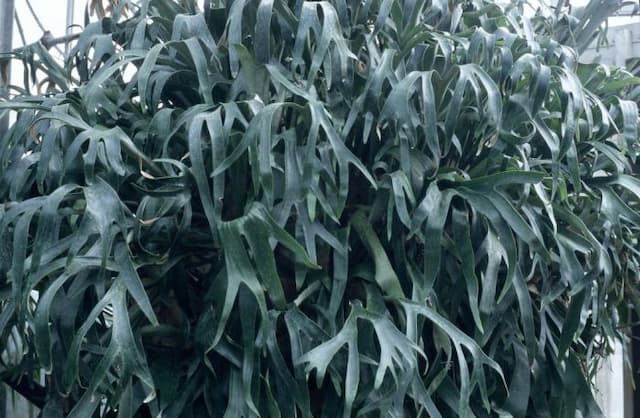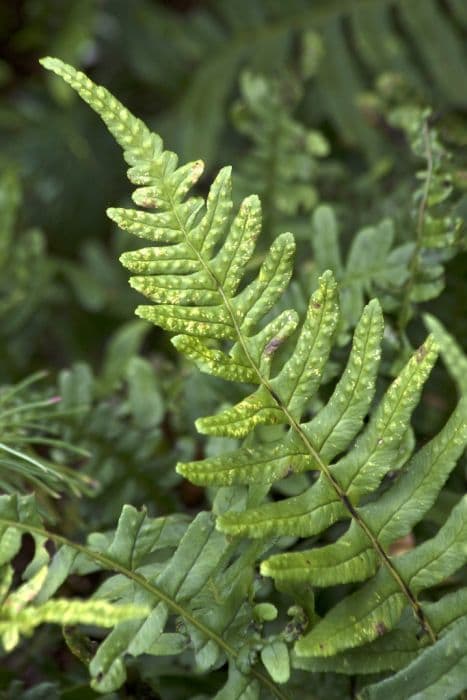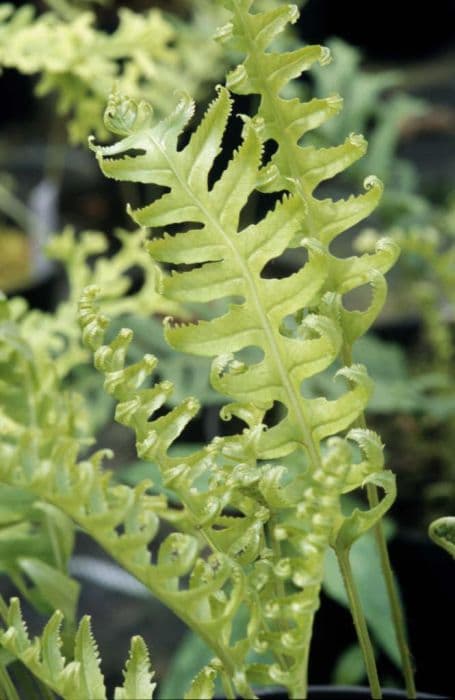Manton's Polypody Polypodium × mantoniae 'Cornubiense'

ABOUT
The 'Cornubiense' is a type of fern that features an attractive and lush foliage. With fronds that unfurl to display their green splendor, this fern has a decidedly robust and textured appearance. The leaves of the 'Cornubiense' are unique as they showcase a crinkled or wavy look, providing a dense and bushy growth habit. The leaflets, or small leaves that make up the larger frond, are arranged in a way that offers a sense of depth and fullness. The surfaces of these leaves are glossy, which catches the light and highlights the wavy contours of the foliage. The plant has a spread-out appearance due to its arching fronds, creating a sense of coverage and decorative appeal. The color of the 'Cornubiense' can be described as a vibrant green, adding a pop of natural color wherever it is planted. Without mentioning specific dimensions, it can be said that the 'Cornubiense' is a sizeable fern that commands attention in its placement due to its distinctive voluminous appearance. The insightful observer can appreciate the way this fern contributes to a garden or indoor space, bringing a touch of the wild and an air of sophistication through its intricately patterned leaves. Overall, the 'Cornubiense' is recognized for its lush and crinkled foliage, making it an appealing choice for those looking to add a textured and vibrant green element to either their outdoor or indoor plant collections.
About this plant
 Names
NamesFamily
Polypodiaceae
Synonyms
Manton's Polypody, Cornish Polypody
Common names
Polypodium × mantoniae 'Cornubiense'.
 Toxicity
ToxicityTo humans
The plant commonly referred to as Manton's Polypody (Polypodium × mantoniae 'Cornubiense') is not typically known for being toxic to humans. There is no well-documented evidence of this fern causing poisoning upon ingestion. However, it is generally advisable to avoid eating ornamental plants as they are not intended for consumption and their effects on human health may not be fully understood or documented.
To pets
Manton's Polypody (Polypodium × mantoniae 'Cornubiense') is not known to be toxic to pets. This means that it is generally considered safe around animals like dogs and cats. Nonetheless, it is always a good practice to prevent pets from chewing on houseplants and ornamental garden plants since individual animals might have unexpected reactions or could choke on plant material.
 Characteristics
CharacteristicsLife cycle
Perennials
Foliage type
Evergreen
Color of leaves
Green
Height
1-1.5 feet (30-45 cm)
Spread
1-1.5 feet (30-45 cm)
Plant type
Fern
Hardiness zones
6
Native area
Hybrid
Benefits
 General Benefits
General Benefits- Low Maintenance: Requires minimal care and is suitable for gardeners with limited time.
- Visual Appeal: Adds aesthetic value to gardens with its attractive foliage.
- Drought Tolerance: Can survive periods of low water availability once established.
- Shade Tolerance: Grows well in shaded areas where other plants may struggle.
- Cold Hardy: Can withstand cooler temperatures, making it suitable for temperate climates.
- Pest Resistance: Generally resistant to common garden pests, reducing the need for chemical treatments.
- Versatility: Suitable for planting in a variety of garden styles, including borders, rock gardens, and woodland settings.
 Medical Properties
Medical PropertiesThis plant is not used for medical purposes.
 Air-purifying Qualities
Air-purifying QualitiesThis plant is not specifically known for air purifying qualities.
 Other Uses
Other Uses- This fern can be used in terrariums or bottle gardens due to its moderate size and tolerance of indirect light, providing a lush, green backdrop.
- Consider incorporating Polypodium into a shaded fairy garden to add texture and create a magical woodland setting.
- Because it's resistant to many pests, it can function as a companion plant amidst more pest-prone species within a shaded garden bed.
- Its durable fronds can be used in floral arrangements to add greenery and forest-like themes to a bouquet or centerpiece.
- Harvested fronds may be used as natural bookmarks that provide a unique and organic feel to your reading experience.
- Can be used for educational purposes, teaching both adults and children about fern life cycles and spore reproduction in plant biology classes or workshops.
- This fern can be used in a ‘green roofing’ project, where it contributes to a layer of vegetation that provides insulation and absorbs rainwater on rooftops.
- It can serve as a natural mulch when its fronds decompose, helping to retain soil moisture and suppress weeds.
- Bathrooms with adequate light can benefit from the humidity-loving nature of this fern, adding a touch of living decor to the room.
- Artisans may use the intricate patterns of the fronds in printmaking, to create botanical prints and nature-inspired art pieces.
Interesting Facts
 Feng Shui
Feng ShuiThe Polypodium is not used in Feng Shui practice.
 Zodiac Sign Compitability
Zodiac Sign CompitabilityThe Polypodium is not used in astrology practice.
 Plant Symbolism
Plant Symbolism- Resilience: As a type of fern, Polypodium × mantoniae 'Cornubiense' often symbolizes endurance and the ability to thrive in challenging conditions due to ferns' ancient lineage and ability to grow in a variety of habitats.
- Eternal Youth: Ferns have long been associated with youthfulness and new beginnings, possibly due to their fresh green fronds and regenerative properties; hence, this plant might represent the idea of perpetual youth.
- Solitude: Ferns are typically found in quiet, shaded forest settings, suggesting a symbol of solitude and a natural connection away from the bustling world.
- Secret Bond: In the language of flowers, ferns sometimes signify secret bonds of love or friendship, as their delicate fronds can conceal their beauty in the depths of the forest, just as some relationships are kept hidden from view.
- Shelter: Ferns provide shelter to many small forest creatures, and as such, may symbolize protection and a safe haven.
 Water
WaterThe Cornish fern, or Polypodium × mantoniae 'Cornubiense', should be watered thoroughly but infrequently, allowing the soil to dry out slightly between waterings. This plant prefers to stay moist but not waterlogged; overwatering can lead to root rot. Generally, watering once every week or two with about 16 to 32 ounces of water, depending on the pot size and environmental conditions, should suffice. During the active growing season in spring and summer, you might need to water more frequently, while in the cooler dormant months, watering should be reduced. Always check the top inch of the soil for dryness before watering to ensure the plant actually needs additional moisture.
 Light
LightThe Cornish fern thrives best under partial to full shade conditions, avoiding direct sunlight that can scorch its leaves. This fern is well-suited to indoor environments where bright, indirect light is present. A spot near a north or east-facing window where the rays of the sun are most gentle, or a location with dappled sunlight, is ideal for the Cornish fern to maintain its vibrant green foliage.
 Temperature
TemperatureThe Cornish fern prefers a moderate temperature range, doing well in environments between 60 and 75 degrees Fahrenheit. It should not be exposed to temperatures below 50 degrees Fahrenheit, as it might not withstand the cold and could suffer damage. The ideal temperature conditions come close to the cool to moderate climates often found in its native habitat, allowing this fern to thrive without the stress of extreme temperature fluctuations.
 Pruning
PruningPruning the Cornish fern is mostly for aesthetic reasons, to remove any yellowing or dead fronds and to maintain a tidy appearance. Pruning can be done at any time of the year as needed, but it's best done in the spring to make way for new growth. Simply use clean, sharp scissors or pruning shears to cut back the undesired fronds to the base. Avoid excessive pruning to ensure the fern maintains its natural shape and appeal.
 Cleaning
CleaningAs needed
 Soil
SoilFor Polypodium x mantoniae 'Cornubiense', commonly known as Manton's Polypody, the best soil mix is one part peat, one part pine bark, and one part perlite. This combination provides excellent drainage and aeration, key for fern health. The ideal soil pH for Manton's Polypody ranges from slightly acidic to neutral, approximately pH 5.5 to 7.
 Repotting
RepottingManton's Polypody should be repotted approximately every two to three years or when the plant has outgrown its current container. Repotting is best done in the spring before the start of the active growing season, giving the plant time to establish in its new pot.
 Humidity & Misting
Humidity & MistingManton's Polypody thrives in a high humidity environment, ideally between 60% and 80%. It is essential to maintain consistent humidity levels, especially if the plant is grown indoors where the air can be drier.
 Suitable locations
Suitable locationsIndoor
Place in bright, indirect light with high humidity.
Outdoor
Keep in shade, shelter from winter, and ensure moist.
Hardiness zone
8-10 USDA
 Life cycle
Life cyclePolypodium × mantoniae 'Cornubiense', commonly known as the hybrid fern 'Cornubiense', begins its life cycle with spore germination, leading to a tiny prothallus—a small, gametophyte phase. On the prothallus, sperm is produced in antheridia and eggs in archegonia; fertilization occurs when water allows sperm to swim to the eggs, forming a new sporophyte plant. This young plant gradually develops roots, fronds, and rhizomes, with the fronds unfurling through a process called circinate vernation. Over time, the fern matures, producing differentiated fronds that perform photosynthesis and contribute to the growth of the plant. Once mature, the fronds develop sporangia, typically on the undersides, where spores are produced through meiosis. These spores are then released to the environment to start a new cycle when conditions are favorable.
 Propogation
PropogationPropogation time
Spring to Summer
Propogation: The most popular method for propagating Polypodium × mantoniae 'Cornubiense', commonly known as the Manton's Polypody, is through division, which is best done in spring or early autumn. To propagate via division, carefully lift the parent plant and use a sharp knife or spade to divide the root system into smaller sections, ensuring each new section has a portion of the roots and fronds. These divisions can then be replanted into pots with well-draining potting mix or directly into the garden, maintaining consistent moisture until the new plants are established. The divisions should be spaced adequately to allow for growth, and they should be kept in a shaded or semi-shaded location as they acclimate to their new environment. After planting, water the divisions well and keep them well-hydrated, without waterlogging the soil, to encourage root development and growth.




